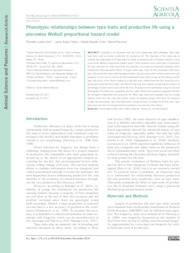Phenotypic relationships between type traits and productive life using a piecewise Weibull proportional hazard model.
Phenotypic relationships between type traits and productive life using a piecewise Weibull proportional hazard model.
Author(s): KERN, E. L.; COBUCI, J. A.; COSTA, C. N.; DUCROCQ, V.
Summary: ABSTRACT: Longevity is an important trait due to its relationship with profitability. Type traits have been used as indirect predictors for productive life. The objective of this study was to evaluate the relationship of 20 type traits on length of productive life in Brazilian Holsteins, using a piecewise Weibull proportional hazard model. Three analyses were performed i) productive life was corrected for within herd level of production as a proxy for functional longevity, which included the time-dependent effects of region within year, class of milk production within herdyear, milk production class within lactation number, fat class and protein contents within herd and (variation in) herd size as well as the time-independent fixed effect of age at first calving and the type trait score; ii) the effects related to production were omitted from the first model (true longevity) and iii) with the first model, the effect of type was also studied considering five classes of percentage of type-scored cows within the herd. All analyses were performed using the Survival Kit program. The final score, angularity, top line, udder texture and suspensory ligament showed the strongest relationship with productive life. When type traits were available only for a small fraction of the herd, the cows had a better chance of remaining longer in the herd. The absence of type trait phenotypes was associated with a strong increase of culling risk for the cows. Type traits were not found to be good indirect predictors of productive life in Brazil.
Publication year: 2018
Types of publication: Journal article
Unit: Embrapa Dairy Cattle
Keywords: Conformation traits, Culling risk, Dairy cattle, Longevity, Survival analysis
Observation
Some of Embrapa's publications are published as ePub files. To read them, use or download one of the following free software options to your computer or mobile device. Android: Google Play Books; IOS: iBooks; Windows and Linux: Calibre.
Access other publications
Access the Agricultural Research Database (BDPA) to consult Embrapa's full library collection and records.
Visit Embrapa Bookstore to purchase books and other publications sold by Embrapa.

